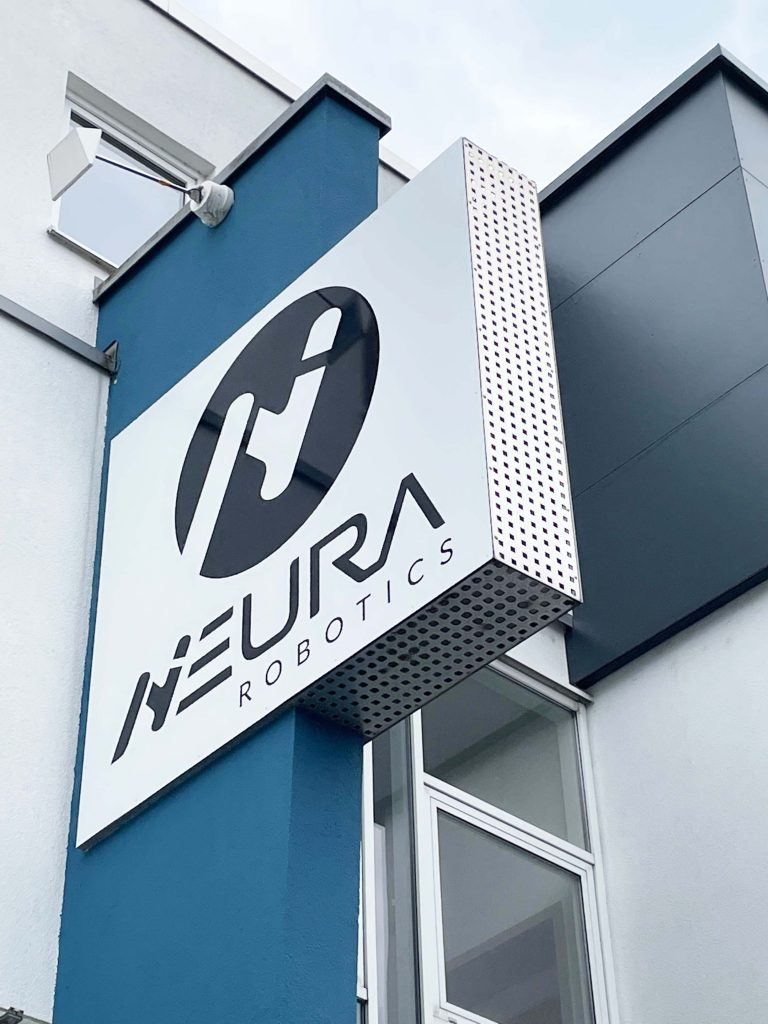Neura Robotics Inside – Besuch des vermutlich nächsten Einhorns (1/2)
Vor wenigen Tagen konnte ich endlich David Reger (Foto oben), Gründer und geschäftsführender Gesellschafter von Neura Robotics, persönlich kennenlernen. Das Treffen fand in den Räumlichkeiten seines Startups in Metzingen statt. Neura Robotics ist mit bislang 86 Mio US-$ eines der weltweit am best- finanzierten Robotik-Startups (Link). Es würde mich nicht überraschen, wenn die Bewertung schon bald die 1 Mrd. US-$ überschreiten würde. Bei der letzten Kapitalerhöhung wurde der Anteil des chinesischen Han‘s Konzern reduziert. Basis hierfür war eine bei der Gründung getroffene Vereinbarung: Erreichen Reger und sein Team die fixierten Ziele, können sie im Zuge von Kapitalerhöhungen westliche Gesellschafter einbinden und erhalten vor allem die IP (s.u.).
Besuchen Sie den Deutschen Robotikverband für mehr Informationen.

Neben der hohen Finanzierungssumme, die sich schon bald signifikant erhöhen dürfte, unterscheidet sich das junge Unternehmen von anderen Startups auf vielfältige Weise. Denn nach Überzeugung von Reger differenzieren sich die heutigen Modelle nur in Qualität und Preis voneinander. Der Preis eines Roboters erreicht dabei nur 10 bis 30% der gesamten Investitionskosten. David Reger wollte günstigere Cobots, geringere Integrationskosten und zusätzliche Differenzierungsmerkmale wie eine sichere Erkennung von Menschen.
Kurze Entwicklungsphase
Offenbar auf Grund der Erfahrungen der Führungskräfte erfolgte die Vorstellung der ersten eigenen Produkte binnen 2 Jahre nach der 2019 erfolgten Gründung. Die typische Lernkurve, die gerade universitäre Startups zurücklegen müssen und dabei den Unterschied zwischen Theorie und Praxis kennenlernen, hatte das Team bereits an anderer Stelle gehabt. David Reger arbeitete beispielsweise zuvor 7 Jahre bei einem Schweizer Automatisierungsspezialisten und entwickelte dort bereits Cobots. Dennoch: „MAiRA“, der nach eigenen Angaben erste kognitive Roboter (Preis wohl unter 40.000 €), enthält zahlreiche Funktionen und Techniken, die es zuvor nicht bei Cobots gab (s.u.). Neben den Roboterarmen wurde im vergangen Jahr mit „MAV“ auch ein mobiler Roboter vorgestellt, der ebenfalls über kognitive Fähigkeiten verfügt. Mit diesem wurde Neuland betreten. Weder Reger noch die chinesischen Gesellschafter von Han‘s Robots hatten zuvor einen fahrbaren Untersatz.
Völlig neue Funktionen
David Reger ist überzeugt davon, dass nur derjenige Erfolg haben kann, der etwas völlig Neues vorstellt oder, um ihn zu zitieren:
„Den Markt von heute haben wir verloren, wir konzentrieren uns auf den Markt von morgen.“
Logisch ist daher die Entwicklung der nächsten Generation an Robotik. So wie der Cobot eine Fortentwicklung des klassischen Industrieroboters darstellt, haben Reger und sein Team mit dem „kognitiven Roboter“ die nächste Evolutionsstufe beschritten, könnte man meinen. Kein heutiger Roboter zuvor war autonom, sie waren nur programmiert, so Reger. Daher hat Neura Robotics Kognition eingeführt: Sehen, Mitdenken, Verständnis, Lernen und Reagieren auf die Umgebung.
Die „MAiRA“-Reihe reagiert auf Sprachbefehle, erkennt den Menschen, lernt durch simples Zeigen und passt sich in der Folge Veränderungen an. Beispielsweise kann „MAiRA“ eine Linie schweißen, wenn der User sie zuvor mit dem Finger abgefahren hat. Liegt beim nächsten Schweißvorgang das Teil anders, weiß „MAiRA“ dennoch wie geschweißt werden muss. Ein Hilfsmittel wie der „TracePen“ von Wandelbots ist daher nicht notwendig. Wandelbots verlangt m.W. zusätzlich immer die gleiche Position des zu schweißenden Teils.
„MAiRA“ gelingt all dies mit Hilfe des breiten Einsatzes künstlicher Intelligenz. Das Erkennen des Menschen ist wegen der maximalen Geschwindigkeit von 4,5 m/ Sec. sehr wichtig. Nähert sich ein Mensch, wird das Tempo reduziert.
Kaum Zukauf
Mit wenigen mir bekannten Ausnahmen (igus und ELITE ROBOTS) kaufen alle Roboterhersteller die wichtigsten Motoren, Getriebe, Encoder zu. D.h. verschiedene Hersteller nutzen vergleichbare Teile, beispielsweise von Kollmorgen, Harmon Drive oder TQ. Damit ähneln sich die technischen Gegebenheiten und das Einsparpotenzial ist begrenzt. Neura Robotics hat diese verdeckte Standardisierung mit Eigenprodukten durchbrochen: Diese bieten zum Teil mehr Funktionen, kosten aber häufig nur einen Bruchteil des bisherigen Preises, so Reger. Diese selbstentwickelten Komponenten sollen in einem nächsten Schritt auch anderen Herstellern angeboten werden. Einige Komponenten sind in Robotern der Schwestermarke Han‘s Robot verbaut. Alles an Kern-Knowhow wie Sensorik wird in Deutschland gefertigt. Mit den Partnern in China besteht eine gegenseitige Abhängigkeit.
Sicherheit hat Priorität
Extrem wichtig für Reger ist die Sicherheit. Diese hat für ihn allerhöchste Priorität und darf beispielsweise nicht dem Wunsch nach einer Skalierung geopfert werden. In der Vergangenheit haben hier einige Marktteilnehmer gespart. Neura Robotics hingegen verbaut hier eine neuartige Technologie, die es den Robotern ermöglicht, sicher und kontaktlos Menschen zu erkennen.
Im zweiten Teil, der voraussichtlich morgen erscheint, geht es um die breite Produktpalette, den Robotikmarkt auch außerhalb der Industrie, aktuelle Umsatzzahlen und den Vertrieb.
Vernetzen wir uns? LinkedIn
-> Zur Cobot-Gruppe auf LinkedIn (Link)
In eigener Sache/ Werbung
Der Autor dieses Blogs ist maßgeblich am KI-/ Robotik-Projekt Opdra beteiligt. Er berät Robotik-Firmen und Investoren bei den Fragen Marktanalysen und Finanzierung/ Förderungen. Mehr zu seiner Person finden Sie hier.
Besuchen Sie den Deutschen Robotikverband für mehr Informationen.

